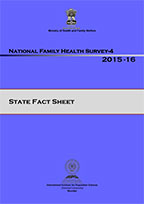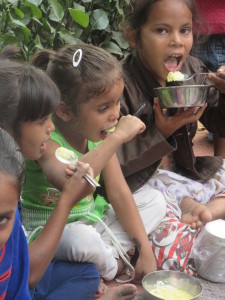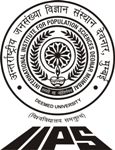High Demand for New India NFHS-4 Data
 Fact sheets with survey results for the first 15 of the States and Union Territories from the 2015-16 National Family Health Survey (NFHS-4) were recently released to much fanfare and a veritable feeding frenzy among the media. The keen interest in the survey results materialized even without a formal dissemination event. The thirst for the results may have been stimulated by how:
Fact sheets with survey results for the first 15 of the States and Union Territories from the 2015-16 National Family Health Survey (NFHS-4) were recently released to much fanfare and a veritable feeding frenzy among the media. The keen interest in the survey results materialized even without a formal dissemination event. The thirst for the results may have been stimulated by how:
- it has been 10 years since the previous NFHS survey,
- the results were made available even before the second-phase fieldwork started,
- the NFHS surveys are considered to be highly reliable, and
- the fact sheets contain a wide variety of key population, health, and nutrition indicators (114 in all), broken down by urban and rural areas and shown in comparison with the 2005-06 NFHS-3 results when possible.

© Fred Arnold/ICF International
The excitement accompanying the release of the NFHS-4 results was a far cry from what I remember happened at the time of the release of the 1992-93 NFHS-1 survey national report. Of course, the key stakeholders who were knowledgeable about NFHS-1 showed up at the dissemination event in large numbers, but it was difficult to generate a great deal of interest among the media, since they were less familiar with the survey or the importance of its results.
The proliferation of news articles and conversations on social media surrounding the results of the NFHS-4 fact sheets are examples of the interest in getting survey results out quickly. Tweets from a variety of users, tagged with #NFHS4, shared links to the fact sheets, complete tables from each fact sheet, and trends in the data.
 The first fact sheets for NFHS-4 are now available from the NFHS-4 coordinating agency, the International Institute for Population Sciences and from The DHS Program, and there is a link to the fact sheets from the website of the Government of India’s Ministry of Health and Family Welfare. Overall, 250 district-level fact sheets have also been released for the same states, each containing 93 indicators.
The first fact sheets for NFHS-4 are now available from the NFHS-4 coordinating agency, the International Institute for Population Sciences and from The DHS Program, and there is a link to the fact sheets from the website of the Government of India’s Ministry of Health and Family Welfare. Overall, 250 district-level fact sheets have also been released for the same states, each containing 93 indicators.
Working on a survey with a sample size of more than 572,000 households, with more than 6,000 field staff, 16 survey field agencies, millions of biomarkers tests, and questionnaires in 18 languages is certainly challenging, but finally being able to see the survey results in the hands of key stakeholders who are in a position to help improve the lives of India’s population makes it all worthwhile. Stay tuned for more results as the second phase of fieldwork has just begun.
For more information, read the Ministry of Health and Family Welfare’s press release.


NFHS-4 data/results can be viewed as baseline data for newly formed states like Telangana and Andhra Pradesh.
Absolutely. There are already state fact sheets for Andhra Pradesh and Telangana, there will also be a separate state report for each of those states, and tables in the national report that are broken down by state will show each state separately. The only challenge is calculating time trends, since there are no estimates for either of the current states in NFHS-3.
I am interested in Telenganareport district level data obtained through NFHS-4 surveys. Could you please let me know how I could access this information.
District-level fact sheets for Telangana can be found here: http://www.dhsprogram.com/publications/publication-OF31-Other-Fact-Sheets.cfm
Amazing work. I can only imagine what it takes to coordinate all this work; indicators at 250 districts???? kudos to you. I would like to request International Institute for Population Sciences to share with me their data processing manual
Many more state and district fact sheets will be coming out by the end of this year. There is no publicly available data processing manual for this survey.
Is there any chance that the raw data from NFHS4 will be available for public download? Or does anyone have advice on how to access that?
The raw data will be publicly available after the national report has been published, sometime next year.
Is it possible to get an estimate of when the raw data might be available for download in 2017?
It’s not possible at this time to give a precise estimate, but the data should be available sometime in the second half of 2017.
Dear Fred, are we any nearer to knowing when the raw NFHS-4 data will be made publicly available?
There’s no further information about the release date for the NFHS-4 datasets at this time.
sir can i get NFHS 4 data for my research work. i am working of NFHS 3 data but if i get new one it will be more beneficial for me
Dear Rajesh,
The NHFS-4 data has not yet been released. You can sign up for email alerts at http://www.dhsprogram.com/email-subscribe.cfm?Email=&emailSignUp_btn=
Thanks,
Sarah
Hi
How to download the NFHS India data?
You can find all NFHS India Final Reports, Fact Sheets, Key Findings, and much more on our website: https://dhsprogram.com/Publications/Publication-Search.cfm?ctry_id=57&c=India&Country=India&cn=India
It’s fantastic to have the district fact sheets out. We’ve just put out a trends report on nutrition using the state sheets, and other material (maps, etc.) using the district level fact sheets.
Trends report – http://poshan.ifpri.info/2017/07/10/trends-in-nutrition-outcomes-determinants-and-interventions-in-india-2006-2016/
Other fact sheets, maps, etc. – htt://poshan.ifpri.info
Is there a place to sign up to get information on when the datasets will be released?
Thanks! Purnima.
Thank you for sharing! You can subscribe to The DHS Program newsletter here: http://bit.ly/DHSsubscribe. We share not only available datasets, but also publications, news, and other announcements.
I was wondering if there is any update as far as NFHS 4 round data is concerned. Thank you,
We currently do not have any updates, but we will announce any releases on Social Media. You can also check updates on the India 2015-16 summary page: https://dhsprogram.com/what-we-do/survey/survey-display-355.cfm.
Hi. How to download raw data for NFHS 3? I need the raw data, not the recoded one.
Still no news on the raw data?
Can you please update about the percentage of urban and rural women population surveyed in India, as per NFHS-4?
The percentage of India’s female population that is urban and rural is included in the NFHS-4 national report, which should be released at a national dissemination seminar in the next few weeks.